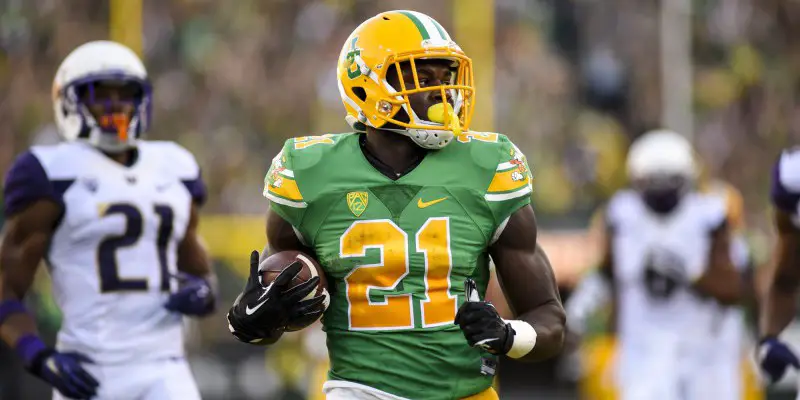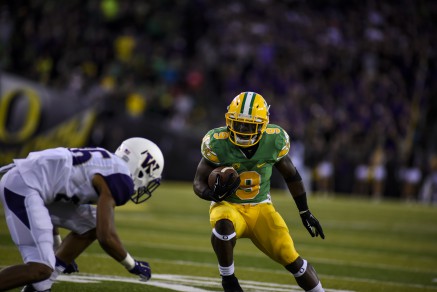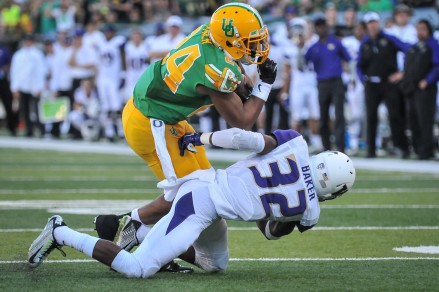I made a mistake the last time I addressed the Ducks’ running back group.
It was early August and everything I was hearing pointed to a two-way race taking place between Byron Marshall and Thomas Tyner for starting running back. I wrote an article for FishDuck about the battle and predicted that Tyner would take on the feature back role. Left out of this article entirely was Royce Freeman.
Only two days after the article was published, on the second day of fall camp, running back coach Gary Campbell had this to say about Freeman with a big smile on his face: “He’s at the point where Tyner was at the end of last year. A lot of times you get guys like him that come in and have great success in high school and they haven’t really had to work at it and when they get into tough competition at the college level they shy away from it. He steps right up.”
These comments turned many heads, including mine. Sure, he was a four-star recruit and an absolute stud in high school. Sure, he drew comparisons to another great Ducks running back, Jonathan Stewart. Sure, Campbell and Mark Helfrich were already giving him the rarest of praise as early as February. But was a true freshman really going to beat out two other very talented backs who were already in a neck and neck competition for lead back status? Turns out it wasn’t as far-fetched as it initially sounded.
Now we’re in late October and my prediction couldn’t have been more incorrect. Freeman has become the most dynamic Ducks running back, Marshall has established himself as a viable slot receiver and although he’s still getting touches, Tyner has gotten somewhat lost in the mix.
Not only is Freeman the most dynamic running back, he has a great chance to be one of the greatest running backs in Ducks history and an impact NFL player in the future. He is simply that good.
We’ve seen glimpses of his greatness nearly every week, but last week’s victory over Washington was Freeman’s coming out party. Along with putting up career highs in yards (169) and touchdowns (4), Freeman ran the ball a career high 29 times. Though it’s unlikely Freeman can sustain that type of workload, he proved last week that he could shoulder the majority of it if necessary.
Freeman’s 6-foot-1, 229-pound frame is what sets him apart from previous Ducks backs since, well, Jonathan Stewart. Over the past several years, the Ducks’ offense has generally been more friendly to backs who excel at running around rather than running through defenders. The best thing about Freeman? He does both exceptionally well.
It’s hard to believe that as a true freshman, Freeman currently has more rushing attempts and yards than Marshall and Tyner combined. But he’s earned every one of those. As surprising as Campbell’s take on Freeman was in early August, it’s probably an understatement now; Freeman didn’t waste any time adjusting to the speed of the college game.
By the time he has a year or two of experience under his belt, we could easily be talking about Freeman in terms of Heisman and first-round pick potential. This is especially possible because whether Ducks fans want to believe it or not, Marcus Mariota is almost surely gone after this year. Whoever inherits his job will very likely not step in and be Mariota-level effective right away. As a result, the Ducks may be forced to lean heavily on their running backs. With Freeman leading a talented group, that won’t necessarily be such a bad position to be in.
Feature Photo by Craig Strobeck
Related Articles:
Chip Kelly Update: Everything's Good Again ...
Chip Kelly Update: Wailing and Gnashing of Teeth
Shock and Awe -- The Oregon Ducks' Football Hangover Effect
Despite Lopsided Score, Georgia State "Never Stopped Believing"
Hope Springs Eternal for Ducks
Incompetent Pac-12 Officials: How Do You Miss ALL of THIS?
Will Denner is a junior at the University of Oregon majoring in journalism with a focus in electronic media. Since he worked for The Oregonian as a freelance sports reporter, he has known for sure that he wants to pursue a career in the field of journalism. Will is most passionate and knowledgeable about Oregon Ducks football, basketball and softball. You can follow him on Twitter @will_denner



